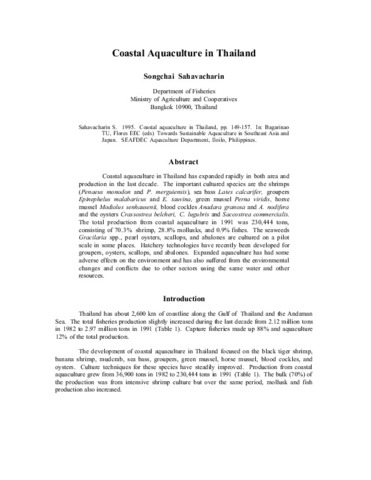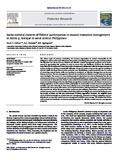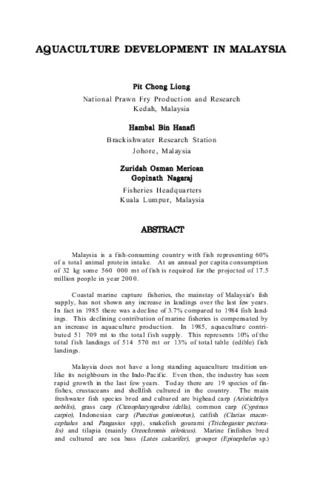| dc.contributor.author | McManus, John W. | |
| dc.contributor.editor | Bagarinao, Teodora, U. | |
| dc.contributor.editor | Flores, Efren Ed C. | |
| dc.date.accessioned | 2011-06-03T09:23:14Z | |
| dc.date.available | 2011-06-03T09:23:14Z | |
| dc.date.issued | 1995 | |
| dc.identifier.citation | McManus, J. W. (1995). Coastal fisheries and mollusk and seaweed culture in Southeast Asia: integrated planning and precautions. In T. U. Bagarinao & E. E. C. Flores (Eds.), Towards Sustainable Aquaculture in Southeast Asia and Japan: Proceedings of the Seminar-Workshop on Aquaculture Development in Southeast Asia, Iloilo City, Philippines, 26-28 July, 1994 (pp. 13-22). Tigbauan, Iloilo, Philippines: Aquaculture Department, Southeast Asian Fisheries Development Center. | en |
| dc.identifier.isbn | 971851127X | |
| dc.identifier.uri | http://hdl.handle.net/10862/122 | |
| dc.description.abstract | Capture fisheries in Southeast Asia are characterized by rampant overfishing, made worse in many areas by problems of overpopulation and by inappropriate management strategies based on misconceptions about tropical fisheries. Mollusk culture and seaweed culture are frequently cited as means to alleviate fishing pressure and to provide substitute protein. There is great potential for expansion of these types of mariculture in terms of area used, species employed, and products generated. However, large-scale mariculture rarely provides significant employment, and the provision of low-cost protein in markets does not alleviate poverty in countries where food production is the primary means of employment. In cases where conflicts have arisen between mariculture development and ecosystem maintenance, mariculture has been favored by inappropriate economic valuations. Small-scale mariculture designed to provide alternative livelihood for fishers is worth developing, although limited by larval supplies and suitable farming areas. Mariculture should be approached as a species-diverse, small-scale enterprise within the framework of integrated coastal management. | en |
| dc.language.iso | en | en |
| dc.publisher | Aquaculture Department, Southeast Asian Fisheries Development Center | en |
| dc.subject | Decapoda | |
| dc.subject | Mollusca | |
| dc.subject | South East Asia | en |
| dc.title | Coastal fisheries and mollusk and seaweed culture in Southeast Asia: Integrated planning and precautions | en |
| dc.type | Conference paper | en |
| dc.citation.spage | 13 | |
| dc.citation.epage | 22 | |
| dc.subject.asfa | fishery economics | en |
| dc.subject.asfa | Small scale aquaculture | en |
| dc.subject.asfa | resource management | en |
| dc.subject.asfa | Sociological aspects | en |
| dc.subject.asfa | integrated coastal zone management | en |
| dc.subject.asfa | carrying capacity | en |
| dc.subject.asfa | environmental impact | en |
| dc.subject.asfa | overfishing | en |
| dc.subject.asfa | mollusc culture | en |
| dc.subject.asfa | aquaculture | en |
| dc.subject.asfa | Catch/effort | en |
| dc.subject.asfa | sustainability | en |
| dc.subject.asfa | aquaculture economics | en |
| dc.subject.asfa | Fishery policy | en |
| dc.subject.asfa | socioeconomic aspects | en |
| dc.subject.asfa | aquaculture development | en |
| dc.subject.asfa | natural resources | en |
| dc.subject.asfa | marine molluscs | en |
| dc.subject.asfa | culture effects | en |
| dc.subject.asfa | coastal fisheries | en |
| dc.subject.asfa | Marine aquaculture | en |
| dc.subject.asfa | seaweed culture | en |
| dc.subject.asfa | fish culture | en |
| dc.citation.conferenceTitle | Towards sustainable aquaculture in Southeast Asia and Japan: Proceedings of the Seminar-Workshop on Aquaculture Development in Southeast Asia, Iloilo City, Philippines, 26-28 July, 1994 | en |



